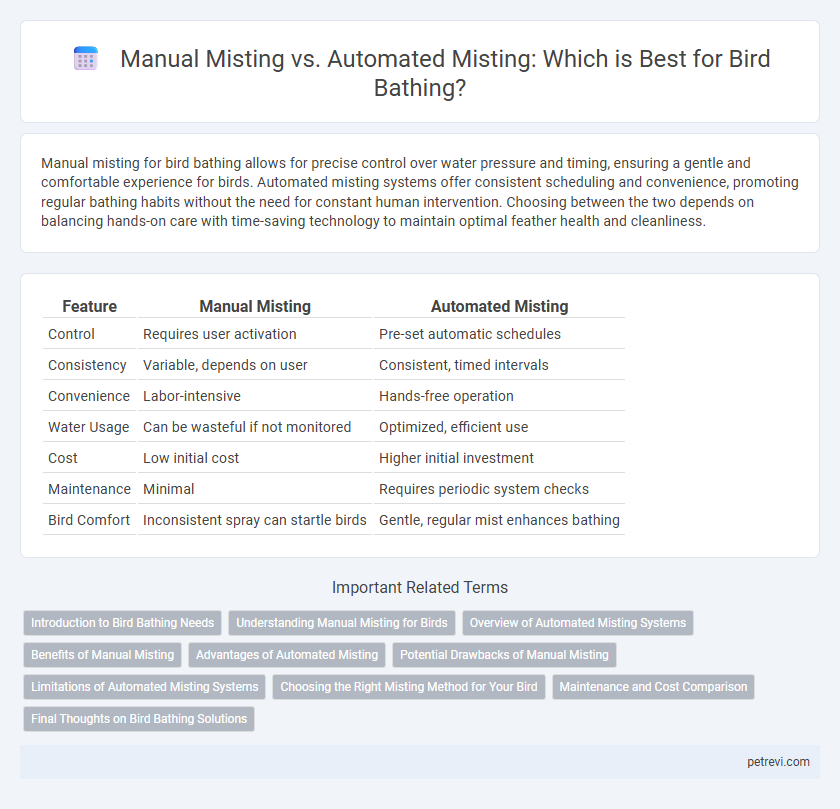Manual misting for bird bathing allows for precise control over water pressure and timing, ensuring a gentle and comfortable experience for birds. Automated misting systems offer consistent scheduling and convenience, promoting regular bathing habits without the need for constant human intervention. Choosing between the two depends on balancing hands-on care with time-saving technology to maintain optimal feather health and cleanliness.
Table of Comparison
| Feature | Manual Misting | Automated Misting |
|---|---|---|
| Control | Requires user activation | Pre-set automatic schedules |
| Consistency | Variable, depends on user | Consistent, timed intervals |
| Convenience | Labor-intensive | Hands-free operation |
| Water Usage | Can be wasteful if not monitored | Optimized, efficient use |
| Cost | Low initial cost | Higher initial investment |
| Maintenance | Minimal | Requires periodic system checks |
| Bird Comfort | Inconsistent spray can startle birds | Gentle, regular mist enhances bathing |
Introduction to Bird Bathing Needs
Bird bathing is essential for maintaining avian hygiene, hydration, and feather condition, requiring consistent moisture application. Manual misting allows precise control over water volume and timing, catering to specific bird species and behaviors. Automated misting systems offer convenience and regularity, ensuring birds receive frequent hydration without constant human intervention.
Understanding Manual Misting for Birds
Manual misting for bird bathing involves using a spray bottle to gently apply water directly onto the bird's feathers, simulating natural rain conditions that encourage preening and cleanliness. This method allows precise control over water temperature and spray intensity, reducing stress and ensuring the bird's comfort during bathing. Regular manual misting can help maintain optimal feather health and hydration, especially for species that thrive in humid environments.
Overview of Automated Misting Systems
Automated misting systems for bird bathing provide consistent and adjustable water delivery, ensuring optimal hydration and comfort for birds without constant human intervention. These systems often include timers and sensors to regulate misting frequency and duration, promoting a natural bathing environment while conserving water. By maintaining ideal humidity levels and cleanliness, automated misting enhances bird health and reduces the risk of illness associated with stagnant water.
Benefits of Manual Misting
Manual misting for bird bathing offers precise control over water pressure and distribution, ensuring a gentle and comfortable experience that mimics natural rain. This method allows bird owners to closely observe their pets' reactions and adjust misting frequency or duration accordingly, promoting healthier feather maintenance. Manual misting also reduces water wastage by targeting specific areas, making it an efficient and eco-friendly option for bird care.
Advantages of Automated Misting
Automated misting systems for bird bathing provide consistent, fine water droplets that closely mimic natural rainfall, promoting healthier feather maintenance and reducing stress. These systems offer precise timing and duration controls, ensuring optimal hydration without water waste or over-saturation. Automated misting also eliminates the need for constant manual intervention, allowing birds to enjoy a reliable bathing environment even in the owner's absence.
Potential Drawbacks of Manual Misting
Manual misting for bird bathing requires consistent attention and timing, which can lead to irregular water application and stress for the bird. This method also risks uneven water coverage, potentially causing inadequate cleaning or overheating if done improperly. In contrast, manual misting lacks the precision and convenience offered by automated systems, making it less effective for maintaining optimal bird hygiene and comfort.
Limitations of Automated Misting Systems
Automated misting systems for bird bathing often face limitations such as inconsistent water pressure and timing, which can result in inadequate coverage and ineffective cleaning. These systems may struggle to mimic the natural variability of rainfall, potentially causing stress or discomfort to birds. Regular maintenance is essential to prevent clogging and ensure the device functions properly, but even with upkeep, automated systems may lack the adaptability of manual misting.
Choosing the Right Misting Method for Your Bird
Manual misting allows precise control over water flow and temperature, making it ideal for birds sensitive to sudden changes or specific bathing needs. Automated misting systems offer consistent, scheduled hydration and cleaning, reducing stress and ensuring regular bathing for busy owners. Selecting the right method depends on your bird species, daily routine, and the bird's comfort with human interaction during bath time.
Maintenance and Cost Comparison
Manual misting for bird bathing requires regular refilling and daily operation, resulting in higher time investment and inconsistent water distribution. Automated misting systems offer programmable schedules, reducing labor and ensuring consistent moisture, but involve higher upfront costs and require periodic technical maintenance. Cost analysis shows manual misting has lower initial expenses but potentially higher long-term labor costs, while automated systems demand investment in equipment with reduced ongoing manual effort.
Final Thoughts on Bird Bathing Solutions
Manual misting offers control and flexibility for bird bathing, allowing customization based on bird species and environmental conditions. Automated misting systems provide consistent hydration and cleanliness with programmable timers, reducing maintenance time for bird owners. Optimal bird bathing solutions balance convenience, water conservation, and bird comfort to promote natural bathing behaviors and overall health.
Manual misting vs Automated misting for Bird bathing Infographic

 petrevi.com
petrevi.com